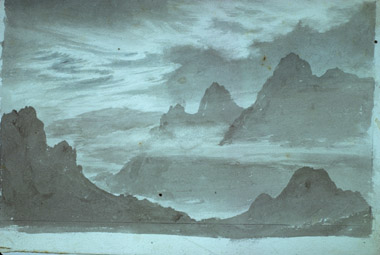
From Luke Howard's Sketch Book

From Luke Howard's Sketch Book

|
Science is a human enterprise devoted to explaining that part of Experience with which man can make contact using his senses of seeing, touching, hearing, smelling, tasting. Western Experimental Science has been an immensely successful venture if success is to be measured in terms of understanding a portion of the ways in which Nature behaves. The basic sciences of Science, namely: physics, chemistry and biology now consist of a very large bank of knowledge of the behavior of matter-energy in its inorganic and organic forms. But Science would not develop until the time was right. The proper intellectual and emotional climate had to have arrived. Further, it would develop only in Western Europe - that part of the world that was capable of providing it with adequate nurture and sustenance. Then, with the advent of men of genius like Copernicus, Kepler, Galileo and Newton, the New Science with all its revolutionary implications was thrust upon the world. There is a real sense, not well understood, in which the advance of Science is tied to the development of Technology. As man interact with Nature in an observational sense, it is not long until he feels the need of extensions of his own senses of observation to help him see the very far away, and the very small. Take the lens, a series of blocks and truncated prisms of glass, cemented together and ground to present to the oncoming and outgoing light a curved surface. By a judicious choice of a combination of lens shapes and positioning it becomes possible to produce a magnified image of an object. This discovery led eventually to the telescope and to the microscope, both of which have enormously extended man's perception of the world without, the macrocosm, and the world within, the microcosm. Where would Astronomy be without the telescope, the spectroscope? Where would Biology be without the microscope? What about Meteorology as a science? There was no such thing in the 18th century, or before. At first thought, this is a bit strange because weather has forever affected human affairs. Why, for instance didn't the science of meteorology precede astronomy, rather than vice versa? The precondition for the development of a science of meteorology was a widely accepted sense that underlying the apparent disorder in the atmosphere, was order. Order was more apparent in the regular movements of heavenly bodies than in the "rather capricious" movements of the atmosphere. The invention of the barometer and the thermometer were crucial devices to the development of meteorology. These instruments had been in general use throughout the 18th century. Various interested individuals had started to keep weather diaries. By the end of the century the laws governing the behavior of gases was becoming reasonably well understood, as was the nature of the sheath of air that surrounded the globe. An insight, essential to the development of the science of meteorology, was that the atmosphere was a system that did obey the laws of physics and chemistry, and that its future state could be predicted if its present and past states were known. This implied: careful measurement of the atmospheric variables of pressure, temperature, and moisture, both at the surface and in the upper air; measurements made at many places over the globe, all made at the same instants of time. Few people had these insights at the beginning of the 19th century. Also technology had not yet produced the transport and communications systems by which the far-flung measurements could be assembled promptly at central locations for analysis. Meteorology had to wait until the latter part of the century for the invention of the telegraph, the refinement of the steam engine etc. to make this possible. Luke Howard is marked as a pioneer in meteorology because he did possess these insights. The work he carried on in the first half of the 19th century materially aided in the development of meteorological science. It is appropriate to present a chronological summary of his achievements.
In assessing Howard's contribution to meteorology we must remember that -- to him -- the subject was a hobby. It was his avocation. In no sense was he a professional scientist. He was a businessman, engaged in the manufacture of chemicals. It just happened that he had become "turned on" to weather, and he never got "turned off". Despite his many other concerns: business, family, friends, Friends, he always remained deeply interested in the subject of weather, and in particular, clouds. Accurate meteorological observations, carried out rather formally over nearly 30 years of his active lifetime, were one of his main concerns. The quality of these observations carried out over 30 years caused him to be ranked as an observer par excellence. |

Luke Howard -- "The Godfather
of Clouds"
Luke Howard -- Cloudman Foreword
| Essay #1 Background Setting
Essay #2 1783 -- A Year to Remember | Essay #3 1802 -- Year of Significance

Cloud History Topics
Luke Howard -- "The Godfather of Clouds | Wilson A. Bentley -- "The Snowflake Man"
![]()
![]()
All Rights © Copyright John A. Day, 1998 - 2007
Site Design by DoubleRich Design
Last updated on: